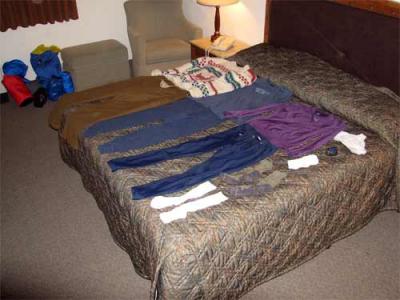Your body is a furnace using cellular respiration to keep you warm. Because it is a furnace it needs to burn fuel that you take in as food. The amount of energy in your food is measured in calories. 1cal = the amount of energy needed to raise 1g of water 1 degree Celsius. 1 Cal = 1000 calories. How many Calories are in a jelly doughnut?
Sedentary people: Weight(lbs) x 14 = Cal/day
Moderately Active: Weight (lbs) x 17 = Cal/day
Active People: Weight (lbs) x 20 = Cal/day
Active and Cold: Weight (lbs) x 26 =Cal/day
How many Calories do you burn hanging around the house? How many would you burn if you were active? How many Calories would you burn if you were active in the cold? How many Jelly doughnuts would that be?
 On the Beaufort Sea Ice.
On the Beaufort Sea Ice.
Since a lot of the energy that you use is lost to the outside. It is important to dress in the cold so we don't lose so much heat. In the Arctic your primary survival shelter is your clothes. So we try to wear loose clothes with layers that will provide dead air spaces. The first layer is designed to wick moisture away from the body. So you start with a sock liner and some long underwear. The next layer captures air next to the body. Wool socks, with either fleece or wool pants and a wool shirt or sweater. The next layer provides insulation and blocks the wind. So I like some insulated coveralls and a heavy down parka. For boots I wear a bunny boots, a rubber boot that has thick layers of wool felt inside to trap air, or Sorrels which have a wool felt liner with a leather upper and rubber foot. To protect your hands, I use a pair of glove liners and a heavy pair of mittens. A face cover and a knit hat finish the outfit. I will take off layers and add layers depending on the conditions.
 Dress in Layers.
Dress in Layers.
You want to avoid clothes that will hold sweat or moisture like cotton. Cotton is good in warm climates, but not so good in the Arctic cold. Water causes the body to lose heat 25 times faster than air.
